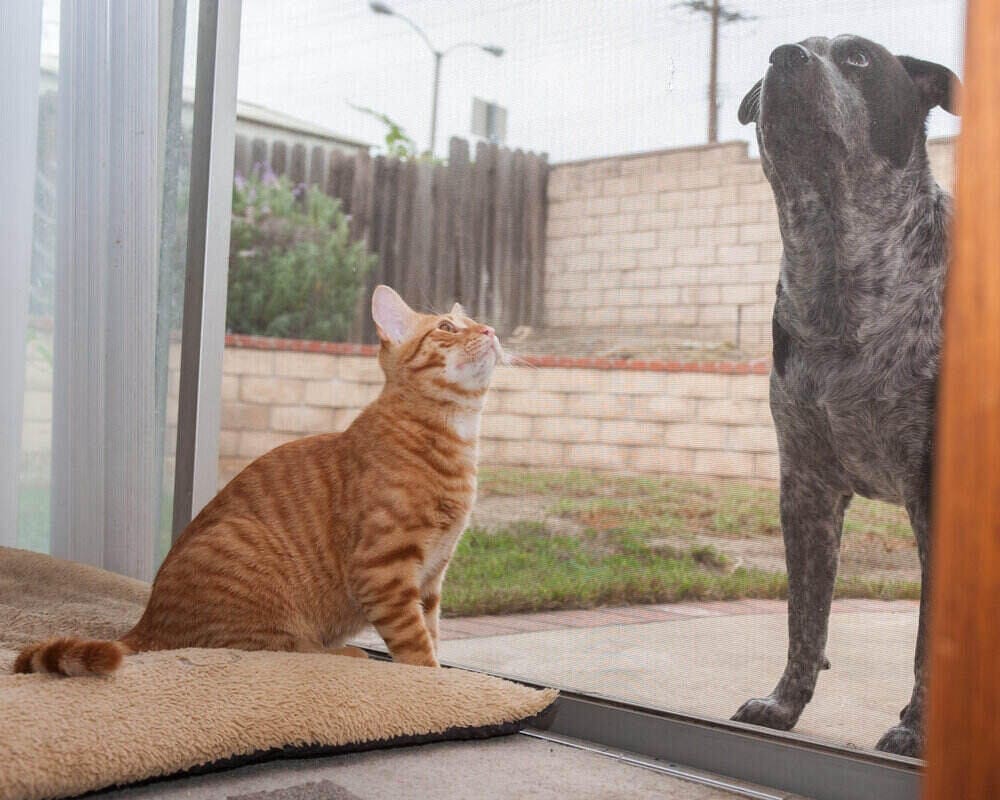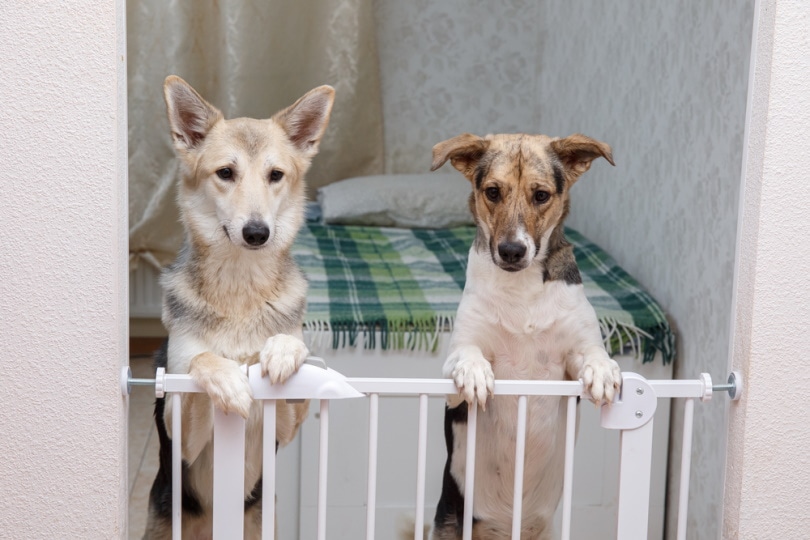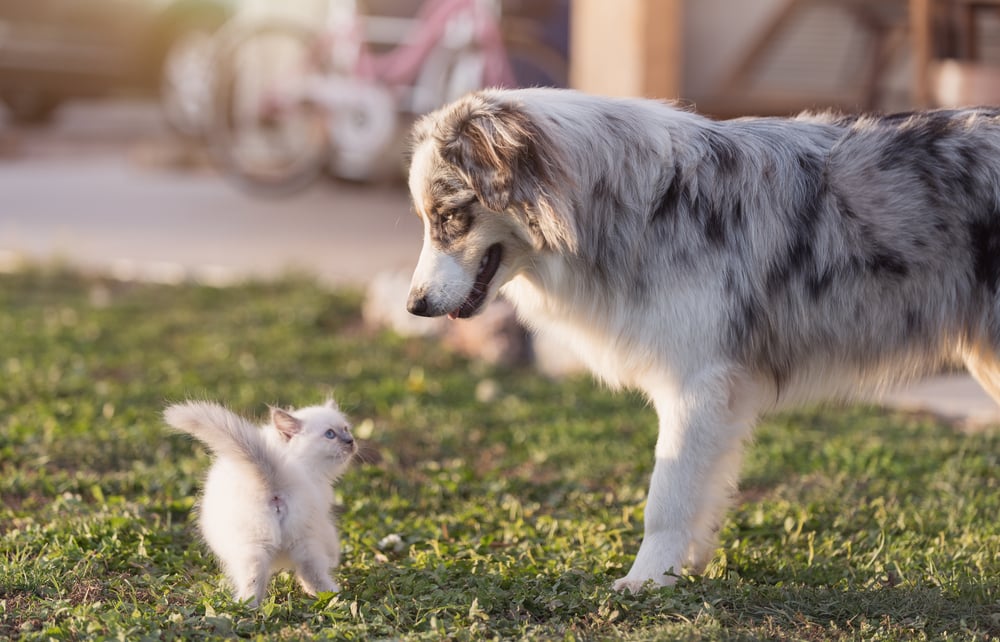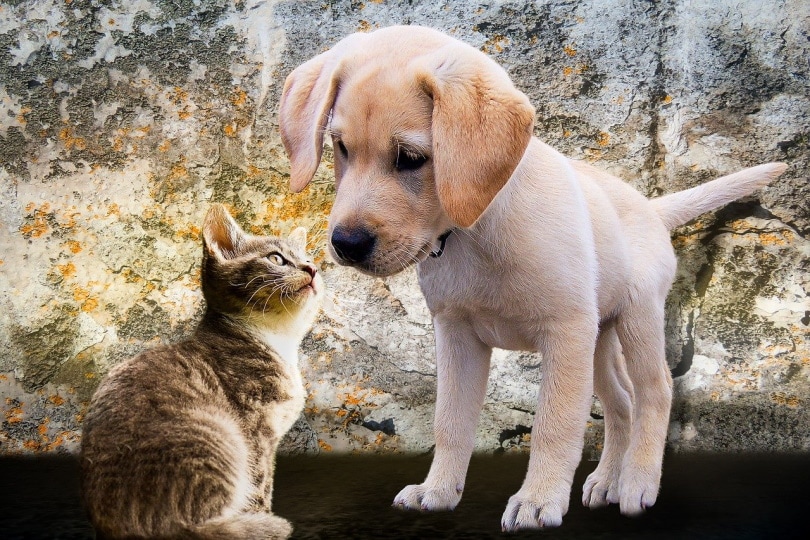Have you ever wondered how to introduce a kitten to your dog? Do you want a kitten but are afraid to adopt because of Fido?
If you are debating about bringing home a little fluffy kitten, there are some considerations you should take to make it as stress-free as possible and ultimately safe for you, your new kitten, and your dog. It’s imperative to find a way to maintain a balanced, harmonious household with a kitten and dog. After all, the kitten will grow into an adult, and you want your dog and cat to become friends and to learn how to live together.
Before thinking about getting a kitten in the first place, consider your dog’s temperament, age and socialization, as some dogs will not be a good match for cats, and such coexistence should not be forced.
In this guide, we’ll look at tips on how to successfully introduce a kitten to your dog so that the end result is pleasant and enjoyable.

The 7 Vet-Reviewed Tips for Introducing a Kitten to Your Dog
Only proceed with these steps if your dog is well socialized with cats, has lived with a cat before or has encountered them and behaved in a calm and friendly manner. Dogs that haven’t been properly socialized, or have expressed any signs of aggression towards cats, should not be introduced to a kitten.
1. Keep Them Separated At First
First and foremost, never assume that your dog will instantly love and accept this new addition to the family. Kittens are active and curious, and there’s a chance that your dog will be confused at first and maybe even overly excited. Even if you think you know your dog very well, their behavior can still be somewhat unpredictable and they should not be forced into a new interaction without necessary preparation.
It’s best to separate your dog and kitten by having a designated room planned in advance. Make sure the kitten has a litter box, food, and water. Your kitten will need to acclimate to you and their new surroundings, so pay frequent visits to the kitten throughout this time to ease any stress and give your dog lots of love to eliminate any possible jealousy. At this stage, the two animals should not see each other, but by spending time with each of them separately, you will slowly introduce them to each other’s scent. Make sure the kitten’s room is secure and they cannot get out, while the dog cannot enter.

2. Let Them Put Their Two “Scents” In
You’ll want to keep the door closed but allow your dog to take a sniff. If your dog scratches or barks at the door or becomes very excited or nervous, gently distract them and remove them from the area until they act calmly and disinterested. When your dog behaves nicely, calm and composed, give them a treat.
3. Use A Baby Gate
After your dog has taken in all the smells, break out a baby gate and open the door. By placing a baby gate, your dog and kitten will be able to see each other for the first time safely. This will allow you to gauge your dog’s reaction to determine where to go from there. If your dog gets overly excited and stimulated, distract them, give them a few minutes to calm down and try again. Reward calm behavior using treats and praise in both pets, with the help of a family member.
Be sure that the gate doesn’t have any holes big enough for the kitten to get through. Keep your dog on a leash and ensure the kitten has plenty of places to hide.

4. Let Them Choose If They Want To Meet, But With Caution
At this stage, you’ll want to have your dog on a leash for safety. Monitor the kitten’s body language toward your dog to determine their reaction. If your kitten is too scared, back off and try again later. The same goes for your dog if there are any signs of uncertainty or excitement. Remember not to rush anything and reward acceptable behavior. Give both animals plenty of time and space, as this step should not be rushed. It can take time for the two to acclimate to one another, and that’s completely normal—consistency and patience are key. Don’t force any interaction, but let the kitten decide if they want to come any closer at this stage or not.
5. Have Supervised Meetings With Your Dog
It may take some time getting to this point, but it’s time to proceed with caution once it arrives. Try letting the two be in the same room with your dog on a very loose leash and generally non restricted movement. You’ll want to monitor closely for any signs of uncertainty or aggression from either animal. Also, remember to reward both animals for good behavior.
If any of the animals show a stressed or fearful body language, stop the introduction and go back a step. It’s important to remember never to leave the two unsupervised, even if they seem to be getting along famously. You never know when the tide may turn, so it’s best to be safe and cautious.

6. Have Some Alone Time With Your Dog
When adding a new addition to the home, try not to deprive your dog of one-on-one time. Take your dog for a walk or go to the park; do anything you used to do with your dog before the new arrival. Doing so will let your dog know that they’re still your priority and the new kitten is not affecting your connection. By tiring out your dog with walks, exercise and mental stimulation, you are increasing the chances of them being calm when interacting with the kitten.
7. Keep It Slow
We can’t reiterate enough to keep things slow. You never want your dog to scare the kitten to where they’ll be scared of your dog for the rest of their life. Remember that first impressions are important and possibly long lasting, so keeping things slow will have a much better outcome. Keep the visits short and supervised each time until all of you are 100 % comfortable.

Frequently Asked Questions
How Long Does It Take For A Dog To Get Used To A Kitten?
Unfortunately, there’s no way to determine the answer to this question. It all depends on your dog and the kitten. Sometimes, it can go very fast, but other times, it can take a few weeks to a few months, while some animals may learn to tolerate each other but never form a close bond. Remember that patience is key and never force the issue.
Why Is My Kitten Hissing At My Dog
Your kitten may hiss at your dog out of fear. Hissing is part of their body language that shows the kitten is uncomfortable and fearful at the moment. If this happens, it’s best to remove your dog from the area and start over slowly. Consider using a synthetic pheromone diffuser in order to provide your kitten with some reassurance during the introductory phase.

Final Thoughts
Having a dog and kitten in the same household can be stressful and worrisome at first. Keeping these safety measures in place will ensure a positive experience and safety for all involved. Never place either animal in a dangerous, unsupervised position, no matter what. With patience, perseverance, and time, your kitten and dog have the best chance to live together in peace and possibly become friends, but this should not be forced, rather let the two of them find a way to live together in the same home.
See also:
- How to Introduce a Hyper Dog to a Cat: 12 Important Tips
- Dog Behavioral Training: Helping Your Pup With Problem Behavior
Featured Image Credit: blende12, Pixabay



















